advocate-summer-2013.. - The Mill Hill Missionaries
advocate-summer-2013.. - The Mill Hill Missionaries
advocate-summer-2013.. - The Mill Hill Missionaries
- No tags were found...
Create successful ePaper yourself
Turn your PDF publications into a flip-book with our unique Google optimized e-Paper software.
A BlessingMay the light of yoursoul guide you,May your worknever weary you,May it release withinyou Wellsprings ofrefreshment,inspiration andexcitement.May you be presentin what you do.May your soul calm,console andrenew you.Amen.(John O’Donohue)
AdvocateSummer 2013 Volume 53 No. 2ST JOSEPH’S ADVOCATEPublished by:<strong>Mill</strong> <strong>Hill</strong> <strong>Missionaries</strong>Editor:Fr. Jim O’Connell.Printed in Ireland by:Modern Printers, Kilkenny.CONTENTSEditorial 2 An Airport at Last 2050 Years a Missionary in Borneo 4 Stop the Trafficking in Persons 22A Night Of Terror 7 <strong>The</strong> Next Generation 26Franciscan <strong>Missionaries</strong> of St. Joseph 10 Devotion to Mary 29Pope Francis 14 Obituaries 32Jubilarians 2013 16Front Cover:Inside Front Cover:Inside Back Cover:Back Cover:Photo Credits:. Maasai Children. Photo: Tony O’Connor.. A Blessing, by John O’Donohue.. Promote Our Magazine.. A Puffin on the Saltee Islands. Photo: D. Foley.. T. Connors, Sr. Anne Moore, D. Harney, Richard Njoroge.ACKNOWLEDGMENTSGrateful Thanks to all our ContributorsMISSION OFFERINGSAll Postal Orders and Cheques to be sent direct to us at<strong>Mill</strong> <strong>Hill</strong> <strong>Missionaries</strong>, Waterford Road, Kilkenny.All Bank Giros to be sent direct toBank of Ireland, Parliament St., Kilkenny A/c No. 10914412. Sort Code: 906064<strong>Mill</strong> <strong>Hill</strong> <strong>Missionaries</strong>St. Joseph’sWaterford Road, Kilkenny.Tel: (056) 7721482Office: millhillkilkenny@eircom.netEditor: jimocmhm@eircom.net<strong>Mill</strong> <strong>Hill</strong> <strong>Missionaries</strong>50 Orwell ParkRathgar, Dublin 6Tel: (01) 4127700E.mail: josephmhm@eircom.netSt Mary’s Parish25 Marquis StreetBelfast BT1 1JJTel: 04890 320482
FROM THE EDITORAt the beginning of the SecondVatican Council in 1962,one of the bishops stood upand remarked that St. Josephwas much neglected in theteaching of the church. Apparently,there was a rather cynicalreaction; this was notexactly the kind of issue that bishops hadbeen summoned to Rome to discuss!But there was a surprise coming; thefollowing day, Tuesday 13th of November1962, Pope John 23rd announced thathe had decided to introduce St Josephinto the Canon of the Mass. This was abold move; he was introducing a changeinto the Canon that was unchanged sincethe time of Pius V at the end of the sixteenthcentury. Pope John was giving anunmistakable message. St. Joseph washis favourite saint and he had earlierplaced the Council in his hands – underhis patronage. He had also given instructionsthat the altar dedicated to St Josephin St Peter’s Basilica should be decoratedand become a centre of devotion forChristians.In 2012, when Pope Benedict XVIproclaimed a ‘Year of Faith’ for theChurch, he emphasised the importance ofSt. Joseph in his reflection about faithand commitment. In announcing theYear's theme, His Holiness urgedCatholics to put themselves under theguidance of Saint Joseph and engage ina ‘spiritual dialogue’ with him. <strong>The</strong> Popesaid: ‘It is more important than ever to2Fr. Jim O’Connell,mhmestablish a kind of spiritual dialoguewith Saint Joseph, sothat he might help us to live inabundance this great mystery’.During a visit to Africa in2009, Pope Benedict emphasizedthe importance of the figureof Saint Joseph: ‘Josephreveals to us the secret of a humanitywhich abides in the presence of mysteryand is open to that mystery in the mostconcrete events of our existence. InJoseph, faith is not separated from action.His faith gave decisive direction to hisactions’.In 1989, Blessed John Paul II wrote:‘St. Joseph’s patronage must be invokedas ever necessary for the Church, as animpetus for her renewed commitment toevangelization in the world. Whether inbringing the first proclamation of Christ,or in bringing it anew wherever it hasbeen neglected or forgotten, the Churchhas need of special ‘power from on high’(Luke 24:49; Acts 1:8) - most assuredlya gift of the Lord's Spirit but, nonetheless,a gift not unrelated to the intercessionand example of his saints…This is where the model that is SaintJoseph leads the way. He is but a manfrom Nazareth, yet, he formed the Manwho would proclaim the Gospel. <strong>The</strong>man in charge of educating the ‘Redeemer’will surely move us to a moreprofound understanding of the Christianmessage – and of our Faith’.ST JOSEPH’S FAITH“<strong>The</strong> discretion with whichJoseph carried out the role entrustedto him by God highlights his faith,which consisted in always listeningto the Lord, seeking to understandhis will and obey it with his wholeheart and strength. This is why theGospel describes him as a ‘justman’ (Mt. 1:19). <strong>The</strong> ‘just’ personprays, lives by faith, and seeks to dogood in every concrete circumstanceof life.Saint Joseph's intrepid faith isprecisely what the Church needs inorder to devote itself to the urgenttask of the new evangelization”.(Blessed John Paul II).Appreciation and thanksWe offer our sincere thanks to all who joined in the Novena to St. Joseph. We hadgood crowds for the Novena Celebrations in our chapel in Kilkenny each eveningat eight o’clock. We also know that many people joined the Novena by praying theNovena prayers in their own homes. We are deeply grateful for the number of youwho wrote to us, sending in the Novena Petitions and a donations. We very muchappreciate the help and support we receive – and continue to receive at this time,when things are difficult and money is scarce. Remember that you share in thegood work of our missionaries around the world. Please continue to pray for them,especially for those who work in difficult and dangerous mission areas. We assureyou that you are remembered in our prayers and masses.3
AS A SCHOOLBOY in AthenryCounty Galway, I dreamed ofliving in a far-away land whereit was always <strong>summer</strong>. At home mymother read parts of themissionary magazine, ‘<strong>The</strong> FarEast’, to us, and showed uspictures of missionary priestsworking in far-away places. Shewould ask us whether we wouldlike to work as missionaries insuch places. Such things didimpress young minds in thosedays long ago.<strong>The</strong>n one day towards the end of mytime in Primary school, a <strong>Mill</strong> <strong>Hill</strong> missionarypriest visited our school andasked whether any of us would like tobecome missionaries in far-away lands.A few of my best friends, classmates, putup their hands, so I put up mine too. Wewere very excited. <strong>The</strong> priest visited ourhomes that afternoon. My parents werevery happy, especially my mother who toldhim that she prayed at Mass every morningthat one of her sons would become apriest. Everything was arranged for me toenter the <strong>Mill</strong> <strong>Hill</strong> Minor Seminary inFreshford at the beginning of the newschool year.Back in school next day, I wasshocked to discover that I was theonly one accepted to enter the Seminary.It was heartbreaking to loseall my classmates, but the prospectof going to a far-away land where itwas always <strong>summer</strong> helped to overcomethat loss.Life in the ‘Interior’ in BorneoAfter ordination at <strong>Mill</strong> <strong>Hill</strong>, Londonin 1963, I was posted to Kuching Diocesein Borneo – Sarawak, East Malaysia.After two years in the coastal region ofDalat, I was assigned to Song parish inthe interior, by far the largest parish in theDiocese that included the large districtsof Kapit and Belaga bordering Indonesia.I carried out my missionary work amongthe many tribal groups in that area, Ibans,Kayans, Kenyahs, Kejamans, Sekapans,Bukitans, Ukits and Punans, among others.I have most wonderful memories ofmy 33 years in that vast hinterland ofBorneo.I well remember the times whenBishop Anthony Lee from the next diocesecame over the mountains with hisspirited Seminar teams to set our remoteCatholic communities on fire with theCharismatic Movement’s ‘Life in theSpirit Seminars’. I remember the several45
days of very difficult travelling into the far interior to reach the nomadic Penans. Ithought I had finally brought the Gospel to the ends of the earth. When I asked theheadman of the farthest inland settlement what it felt like to live at the ends of theearth, I was quickly cut down to size when he let me know that we had just reachedthe centre of the world, not the end of the earth.A hunting expedition – with a differenceOnce on visiting a very large Kenyah settlement after a two-day journey up theBalleh River, all the men folk had gone far into the jungle in search of expensive fragrantheartwood. <strong>The</strong> women had to fend for themselves. That evening all the youngladies held a meeting to divide into four hunting groups, about 15 to each group.<strong>The</strong>y invited me to join the wild boar hunt next day. I joined those going down river.Each lady held a spear with a sheathed sword tied round her waist. As we rounded abend in the river, a large number of wild boar were at the tip of a long stretch ofgravel, ready to swim to the opposite bank, but they bolted back as soon as they sawus. <strong>The</strong>y just missed our boat as it ran onto the gravel bed. <strong>The</strong> women and theirmany dogs shot from the boat after the wild boar with such speed that I was leftsitting dumbfounded, mouth wide open. With the driver, I followed the boar chaseby boat down river guided by the jungle orchestra of yelping dogs, squealing wildboar and screaming women for quite a distance. Finally, we heard them cheering astheir dogs surrounded a large number of boar. <strong>The</strong>y speared 14 of them. My role inthe boar chase was to help carry the boar carcasses back to the boat, leaving heavyboar heads and legs behind.A Wonderful CallingAfter such experiences in the wilds of the interior, it was then a total change to betransferred to town life at Sacred Heart Cathedralwhere I have been for the past 13 years. At firstI felt like a fish out of water, but now feel athome in every home here. I thank the Lordfor having saved me from the cruel Irishweather and placing me in the land ofeternal <strong>summer</strong> among the most wonderfulpeople on earth, whether it bethe well-to-do Chinese here in Sibu, orthe nomadic Penans in the far interior.In my wildest dreams, I could neverhave imagined a more wonderful callingthan this missionary life in SoutheastAsia.Photo of a Borneo Longhouse, where eachfamily lives in one room.By Fr. Donal Harney, mhmIWILL never forget that dayand the night that followed. Ileft Nagongera Seminary,taking a student to MbaleHospital - fifty miles away. As Ineared the town, I noticed moresoldiers than usual on the road,which gave me an uneasyfeeling. Let’s hope there isnothing wrong I thought tomyself.I got the student admitted in the hospitaland it was there also that my worst fearswere confirmed. A military Coup had takenplace in Kampala. President Milton Obotehad already fled the country, after beingousted by General Tito Okello. When I leftthe hospital, I could see the shopkeepers ofthe town already boarding up their premises.A tense atmosphere filled the air andpeople began to flee the town. This was notime to be on the road, so I made my wayto Mbale College, which was on a hill justoutside the town. I had been a teacher therein the late 1960's.7
It was now timeto run for itVery soon a white Susuki United Nations’vehicle drove up to the College; ithad been hijacked and two soldiers withAK47's jumped out. Before we realisedit both my car and that of the headmasterhad been robbed from us at gunpoint. Iwill never forget the sinking feeling I hadas I watched my car being driven awayat high speed. This was not the end.Very soon we could hear the sound ofgunfire all over the town. <strong>The</strong> looting hadstarted. <strong>The</strong> college was on a hill overlookingthe town and now we could seemore soldiers making their way up to thecollege, firing in the air as they came. Itwas now time to run for it.Two students, who had remained behindduring the holidays to do somestudy, led me to a secret hole in the wirefence where I could get out. Studentsknow how to escape from school Ithought to myself! At the same time Iwas glad to have this secret exit. I ran asfast as I could down a valley, passingthrough a banana plantation, then a coffeeplantation, until I came to a drystream at the foot of the hill - anything toget away from the line of fire.<strong>The</strong> evening wasnow falling - Iplanned to hideEvening was now falling and I plannedto lie down and hide in the high grass.8Soon a young man came towards me.‘Come and stay with us’ - he said. Hebrought me to his home where a smallgroup of people sat around outside thehouse, speaking in hushed tones. <strong>The</strong>gunfire from the town grew louder andlouder as it echoed from Mount Elgonwhich lay behind us. I sat among them,the only white person. Food was broughtto me but I had no appetite.A sleepless night -but notfor the childrenDarkness had now fallen and we wereglad of it, but the shooting still continuedin the distance. <strong>The</strong> hours slipped by andat around four in the morning, there wasless shooting. My kind friend told methat it was now safe to go inside and rest.<strong>The</strong> house was a mud cabin. I just sat up– waited and prayed. At around six oclock the gunfine began to stop and tomy delight I could now see rays of sunlightcreeping through the cracks in theclay walls of the house. <strong>The</strong> soldiersnever came to loot where we were. Insteadthey had gone to the wealthy suburbsof the town. Afterwards, we alsoheard that civilians took part in the looting.<strong>The</strong>re was no road to the placewhere I stayed and in fact I had spent thenight in what could be called a "safehouse".I could now hear the happy sound ofsmall children. Evidently they had sleptthroughout the whole ordeal. It was timefor me to say goodbye and to thank mygood friends who sheltered me. I mademy way back to the college. All wascalm. A few days later, Fr.Kiwanuka,who was the rector of the seminary, cameto collect me. We made a brief stop in thetown to view the destruction. <strong>The</strong> wholeplace was in a shambles with brokenwindows and bits of furniture scatteredeverywhere. A tall white man came walkingtowards me. He was an official of theU.N. ‘What nationality are you, sir? -Are you aware that there is an evacuation?’I told him I was a missionary andthat as missionaries we did not like toleave the people we had come to serve.Some years later when everything waspeaceful once again I felt that I had a littlebit of unfinished business to attend to.‘I really must go back to Mbale andthank those kind people who had shelteredme during that terrible night’. Butthat mud house had long since beenpulled down and the people had goneaway. New people had come to the areaand erected their own shanty dwellings.Life had moved on and the people whowere kind to me were no longer there toreceive my thanks. But we know thatGod will bless and reward them: ‘I wasa stranger and you took me in… As longas you did it to one of these the least ofmy brethren, you did it to me’ - Jesussaid.In a more peaceful setting: With some members of his Kilkenny Legion Of Marygroup. From left to right: Fr. Donal, Anna Maher, Eileen Nugent, Carmel Hoganand Con Nyham..
By:Sr. Anne Moore,fmsj.THE TOWN of Kisumu on theshores of Lake Victoria inWestern Kenya is a far cryfrom Shawlands on the southside of Glasgow (Scotland)where I grew up. But this is thedirection my life has taken me asa Franciscan Missionary of St.Joseph.10I joined the Congregation because Iwas attracted to them by the stories andpictures of nuns on mission in Africa intheir missionary magazine. This was theway God planted the seed of vocation inmy heart, the call to greater intimacywith God as well as to a Franciscan wayof life in community and ministry. Afterinitial formation and teacher training inManchester, I set off for Kenya where Iremained for over thirty years sharing mylife with people who are among the mostisolated, vulnerable, voiceless and mar-ginalized in our world.<strong>The</strong> Franciscan <strong>Missionaries</strong> of StJoseph are an international congregationfounded in 1883 by Alice Ingham whocame from Rochdale, in the north ofEngland. Alice had a strong desire to dosomething special for God and a longingto be a more compassionate presence inthe world. By forming community withlike-minded local women, all membersof the Franciscan Third Order, Alice wasled to a deeper and more meaningful expressionof the Gospel through her ministryto those around her.Connections with <strong>Mill</strong> <strong>Hill</strong>As followers of Francis of Assisi andAlice Ingham today, we have a simplelife style in community, serving theChurch in every waywe can.Since our foundation in 1883, we havebeen closely associated with the <strong>Mill</strong> <strong>Hill</strong><strong>Missionaries</strong> and, in Kenya and Ugandaespecially, are often known as the <strong>Mill</strong><strong>Hill</strong> Sisters. We claim Bishop (later Cardinal)Herbert Vaughan, the founder ofthe <strong>Mill</strong> <strong>Hill</strong> <strong>Missionaries</strong>, as our cofounder- because it was he, as Bishop ofSalford, who gave our community, theapproval of Ecclesiastical authority.Bishop Vaughan invited Alice and hercompanions to go to St Joseph’s Collegein <strong>Mill</strong> <strong>Hill</strong>, London, founded seventeenyears earlier for the formation of missionarypriests, to take over the domesticmanagement of the College. <strong>The</strong> Sisterscontinued to provide this service in allthe <strong>Mill</strong> <strong>Hill</strong> Colleges for over one hundredyears. From the early days, the Sistersalso joined the <strong>Mill</strong> <strong>Hill</strong> <strong>Missionaries</strong>in Malaysia and Africa where we haveworked closely with them to the presentday.Bishop Vaughan also started theCatholic Children’s Rescue Societyin Salford Diocese to providehomes for orphans and destitutechildren and the Sisters werebrought in right at the beginningof this venture to care forthem, and over the years cameto be known as the ‘RescueSisters’ in the diocese.How we serveAt the present time the Franciscan<strong>Missionaries</strong> of St.Joseph are serving in the UK,Ireland, Kenya and Uganda,Ecuador and the Netherlands.11
Previous page: Sr. Flora and school children. Above: Sr. Anna and children with disa bility.Opposite page: Sr. Margaret and Vincent (social worker) with street children. All in Kenya.in teaching in poorer areas, running communitybased health care programmes,running Street Children’s programmesand providing services for disabled childrenwho are generally hidden at home.We are also involved in pastoral and socialwork in various ways, one of whichis helping widows and orphans who aretrying to survive in the direst of circumstances- often living in the slum areas oreven homeless. <strong>The</strong> Sisters have beenable to help some of these to buy a smallpiece of land and build a semi-permanenthouse, as well as start a small business,such as selling vegetables, to eke out aliving.In the United Kingdom we ministerin parishes, chaplaincies, and homes forthe elderly, are active in mission awareness,and help the homeless in variousways. We care for children and familiesthrough involvement with Caritas (Dioceseof Salford) and Francis House,which is a children’s hospice. In theNetherlands, we have four Sisters retiredand living in the <strong>Mill</strong> <strong>Hill</strong> Retirement Home.In Ireland, our Sisters are running aResidential Home for the elderly inFreshford, County Kilkenny. One Sister,who is a nurse, is looking after the elderly<strong>Mill</strong> <strong>Hill</strong> <strong>Missionaries</strong> in their RetirementHouse in Rathgar, Dublin. Wealso have a house in a housing estate inDublin where the Sisters are involved inwork in the local parish. Our Sisters arealso in Blackrock Road, Cork; this ismainly a house for retired Sisters.As Franciscan <strong>Missionaries</strong> of St.Joseph we believe that we are called tobring hope to those around us, sharingthe desire of St. Francis of Assisi to be atthe service of the Church and at the heartof her life.For more information, please contact:Sr. Peggy Lonergan, Prague House,Freshford, Co. Kilkenny.Or email: srbridget@eircom.net.We also have a website:www.fmsj.co.ukOur biggest growth in terms of vocationsis in Kenya, where we have youngwomen joining our congregation everyyear. We have eight communities inKenya and one in northern Uganda,opened last year.Our sisters are involved with peoplewho struggle to survive on a daily basis.One example of this is our new missionin northern Uganda, among the Karamojongpeople. In this area the mortalityrate for pregnant women and their unbornbabies is high because they cannotaccess maternal and child health clinics.<strong>The</strong>re are many malnourished children12and children who are not immunizedwhich adds to the high child mortalityrate. <strong>The</strong>re is a lack of access to safedrinking water also contributing to thehigh rate of disease. <strong>The</strong> school drop outrate is high. One of the reasons for thisis hunger. School attendance depends onthe availability of food provided by theWorld Food Programme. Four of ourKenyan Sisters went there last August towork alongside the <strong>Mill</strong> <strong>Hill</strong> <strong>Missionaries</strong>and they hope to make a difference tothe lives of the people there by trying toaddress these needs.In Kenya and Ecuador we are involved13
14IT WAS a moment of rare magic,both humble and holy. <strong>The</strong> 76year-old Argentine Jesuit,Cardinal Jorge Mario Bergoglio,stepped out on the balcony of theBasilica of St Peter's and said asimple, ‘Buona sera’ – goodevening.With just two words, he suggestedthat things were going to bedifferent around here - different fora thousand reasons. He is the firstLatin American Pope - a longoverdue acknowledgement thatnearly half the world's Catholics livein Latin America. He is the first Jesuit popeand the first Pope Francis. All of this is obviousenough and clearly very different.However, the biggest difference of allwas the aura of genuine humility: “<strong>The</strong>conclave had the task of finding a bishopfor Rome. It seems as if my cardinal brotherswent practically to the ends of the earthto find one” - he said. That remarkprompted an immediate burst of applause,mixed with laughter, from the crowd in St.Peter’s square. It helps, of course, that hespeaks fluent Italian. He moved into arecital of the Lord's Prayer, followed by hispromise that “we are about to begin a journeytogether, the bishop and his people ... ajourney of brotherhood, fraternity andtrust... let us pray for one another, let uspray for the entire world”. <strong>The</strong>n Pope Francisdid another very simple, humble thing.Before giving his blessing, he asked “afavour” of his listeners: “Please pray forme”. In that moment of silence the newpope bowed his head in prayer…<strong>The</strong> beginning was more than promising.Yet can Pope Francis deliver on thegreat expectations that accompany hiselection? Will his pontificate see theCatholic Church become much more a“church of the poor”? … He has long hadan impressive reputation for simplicityand humility. As archbishop, he chose tolive in a simple apartment rather than thearchbishop's palace. He gave up hischauffeured limousine in favour of takingthe bus to work, and cooked his ownmeals…Pope Francis was born inBuenos Aires in 1936, theson of an Italian immigrantand railwayworker from Piedmont.He originally wanted tobe a chemist, but in1958 opted instead forthe Jesuits...(PaddyAgnew in <strong>The</strong> IrishTimes, March 14th 2013)Pope Francis about St.Joseph (from his homily atthe Inauguration Mass):“How does Joseph exercise his role asprotector of Jesus, Mary and the Church?Discreetly, humbly and silently, but withan unfailing presence and utter fidelity,even when he finds it hard to understand.From the time of his betrothal to Maryuntil the finding of the twelve-year-oldJesus in the Temple of Jerusalem, he isthere at every moment with loving care.As the spouse of Mary, he is at her sidein good times and bad, on the journey toBethlehem for the census and in the anxiousand joyful hours when she gavebirth; amid the drama of the flight intoEgypt and during the frantic search fortheir child in the Temple; and later in theday-to-day life of the home of Nazareth,in the workshop where he taught histrade to Jesus…Joseph is a “protector” because he isable to hear God’s voice and be guidedby his will; and for this reason he is allthe more sensitive to the persons entrustedto his safekeeping. He canlook at things realistically, he isin touch with his surroundingsand he can maketruly wise decisions. Inhim, dear friends, welearn how to respondto God’s call, readilyand willingly, but wealso see the core of theChristian vocation,which is Christ! Let usprotect Christ in our lives,so that we can protect others,so that we can protect creation…<strong>The</strong> vocation of being a “protector”means protecting people, showing lovingconcern for each and every person, especiallychildren, the elderly, those in need,who are often the last we think about. Itmeans caring for one another in our families:husbands and wives first protectone another, and then, as parents, theycare for their children, and childrenthemselves, in time, protect their parents.It means building sincere friendships inwhich we protect one another in trust, respect,and goodness”...15
<strong>Mill</strong> <strong>Hill</strong> Jubilees - 2013FR. LARRY ENGLISH60 years - Diamond JubileeFr. Larry English is from Tullamore – in the heart of Ireland. He stillremembers fondly the bog of Allen, the Slieve Bloom Mountainsand nearby Clonmacnoise. His early education was by the Nuns andlater the Christian Brothers, before he left for Freshford to join <strong>Mill</strong><strong>Hill</strong>. After ordination he was appointed to the Philippines. Heworked in a parish in Iloilo city for a few years and later spent sevenyears in a parish in rural Antique.His next move was to the UnitedStates – to St. Louis, MO, where he was superior of the <strong>Mill</strong> <strong>Hill</strong> House and involved infundraising with ‘a wonderful group of people’.After seven years, he returned to the Philippines to the parish of Barbaza in Antique,where he built a beautiful church, with financial help from the people of Tullamore. Thiswas scarcely finished when he was appointed back to the United States. He was assignedto Los Angeles for a short while and then to hospital chaplaincy work in Jacobi hospitalin the Bronx, New York. This was very challenging and interesting work. In 1990, hereturned to Ireland and spent a number of years in Kilkenny, as Editor of St. Joseph’s Advocate.He is now living in the <strong>Mill</strong> <strong>Hill</strong> Retirement Home in Rathgar, Dublin.FR. JOSEPH P. WHELAN60 years - Diamond JubileeFr Joe Whelan is from Dublin. Joe’s first appointment after ordinationwas to UCC University, to get a degree that would prepare himfor his work in education in Uganda. That was his destination aftergraduation and he spent sixteen years in Colleges there.He was expelled by Idi Amin in 1972 and took up different posts inEurope and the USA for the next 10 years, which included three yearsin Freshford, Co Kilkenny (1977-1980), as Director of the Organising and Fundraising.After the fall of Amin he returned to Uganda for another four years, until health problemsbrought him back to Europe. He spent the following six years in Liverpool and Ireland.In 1993, he was asked to go to the Falkland Islands and from there he moved to the Islandof St Helena in the middle of the South Atlantic Ocean (See his article about St. Helenaon page 20). <strong>The</strong>re are less than 5000 people there and not many Catholics. Commentingon his time there Joe says: ‘a missionary goes where he or she is sent’. This ended in2004 when it was decided that, with his health problems, he should remain in Ireland.He worked for a few years helping overseas aid through Irish Aid. He is now retired inour Dublin house, ‘waiting in the Departure Lounge’- as he himself says.FR. ANSELM AHERNE50 years - Golden JubileeFr Anselm Aherne is from Belgooly, Kinsale, Co Cork. His firstappointment was to Jesselton, now called Kota Kinabalu, inSabah, Malaysia, on the island of Borneo. <strong>The</strong>re he taught in theTambunan School, which also had a convent school attached toit and a mobile clinic catering for the surrounding kampongs (villages).He moved to three other parishes with schools attached, until in December 1970, thecountry decided not to renew the work permits of foreign missionaries. He was thenappointed to the Maori Mission in New Zealand and was assigned to Rotorua, a cityParish in the care of the Maori Mission.He soon moved to Panguru parish, where the first Mass was celebrated by NewZealand’s first Bishop, Frenchman, Bishop Pompallier, on 13th January 1838. BishopPompallier died in France and his body was returned to New Zealand at the requestof the Maori people and re-interred in Motuti. It is now a place of pilgrimage.Six years on, Anselm was back in St Michael’s in Rotorua, which was one of thefirst Parishes started by the <strong>Mill</strong> <strong>Hill</strong> Maori Mission priests when they arrived inNew Zealand in 1888. He continued to work in Rotorua until February 2008 whenhe was appointed to St Columba’s, Frankton, in Hamilton - close to where the lateFr Gerry Haring built a Maori Marae (traditional Maori gathering place) with a littlechapel attached. Anselm is still working in Hamilton.FR. TOM CONNORS50 Years - Golden JubileeFr. Tom Connors is from the Athenry area of Co. Galway. After ordinationat <strong>Mill</strong> <strong>Hill</strong>, London, in 1963, he was appointed to the Borneohalf of Malaysia in Southeast Asia. During his first two yearshe taught in Dalat School, after which he spent a short period inSarikei at the end of 1965. Early in 1966 he was appointed to theparish of Song - deep in the ‘interior’ of Borneo. Song then includedKapit and Belaga, the most extensive parish in the Diocese of Kuching and more thanhalf the size of Ireland. He was engaged in primary evangelisation and pastoral work inthat vast area for the next 33 years.At the beginning of 1990, Song, Kapit and Belaga became separate parishes. Tom wasstationed at Kapit until 1999 when he was transferred to Sacred Heart Cathedral, Sibu.From there he did pastoral work in the Sekuau, Tamin and Selanggau area, which is nowa separate parish. He continues to work among the mixed communities of Sibu at SacredHeart Cathedral and in Longhouse Communities in that area as well. (Fr. Tom still worksin Borneo - for more about his 50 years there, see his Article on page 4)16 17
18<strong>Mill</strong> <strong>Hill</strong> Jubilees - ContinuedFR. MAURICE CREAN50 Years - Golden JubileeFr. Maurice Crean is from Keelballylahive, Castlegregory,Co. Kerry. His first appointment was to the teaching staffof St. Joseph's College, Freshford. He was appointed toKenya in 1966 and worked there for the next 14 years inthe Diocese of Kisumu. Names such as Kisoko, Mukumu,Malindi and Erusui still bring happy memories of peopleand places, Christian communities, celebrations and variousdevelopment programmes.After following the 1980-81 Course at the Carlow Liturgical Centre, he was appointedto the Vocation Promotion Team in Ireland. He was elected Regional Superiorof the Irish Region in December 1982 for six years.This was followed by a study break in Fordham, New York, before returning toKenya in 1990. He served at the Cathedral parish in Kakamega and as Vicar Generalof the Diocese for a few years. His last six years in Kenya were spent as RegionalSuperior. During those years, the <strong>Mill</strong> <strong>Hill</strong> members in Kenya wereinvolved in implementing the 1988 Chapter decision to recruit and train candidatesfrom the local church to become <strong>Mill</strong> <strong>Hill</strong> <strong>Missionaries</strong>.At the end of 1998 he attended a short course at the spirituality centre of St.Beuno's and then became Rector at Kilkenny, as well as Director of promotionwork and fund raising. In the spring of 2001 he was elected Regional Superior(for a second time) and moved to Dartry. He returned to Kilkenny in 2008 to thejob he had left in 2001 – heading up the promotion work and fundraising for <strong>Mill</strong><strong>Hill</strong> in Ireland.We congratulate our Jubilarians asthey celebrate many years ofmissionary service in thePhilippines, Borneo, Uganda, Kenya,New Zealand, the Falklands and St.Helena. We also remember the greatwork that some of them have done inIreland, England and the UnitedStates of America.FR. PHILIP O’HALLORAN25 YEARS - Silver JubileePhilip O’Halloran is from Callan, Co. Kilkenny. After ordinationin 1988, he spent 21 years in Uganda. His first fiveyears were in Soroti, which was recovering after devastationby government soldiers, anti-government rebels and Karimojongcattle raiders. He worked in Soroti Cathedral andlater in Kaberamaido Parish. He also was Vice-Rector andtaught in the Diocesan Seminary for two years, as well asrunning the Diocesan Finance Office during his time in the diocese. From June1993, he ran the <strong>Mill</strong> <strong>Hill</strong> Uganda Vocations Office near Jinja. For one year,from April 1998, he led a team of <strong>Mill</strong> <strong>Hill</strong> <strong>Missionaries</strong> who opened the first<strong>Mill</strong> <strong>Hill</strong> Parish at Panyangara in Kotido Diocese, Northern Uganda.He then returned to Ireland for a sabbatical before being appointed to the FormationProgramme in Jinja for two years from 2000. He volunteered to return toKotido after the killing of Fr. Declan O’Toole in March 2002, and led the <strong>Mill</strong><strong>Hill</strong> team there until March 2009. After a year’s study he took up a short-livedappointment to <strong>Mill</strong> <strong>Hill</strong> Kilkenny in June 2010. Since July 2011, together withthe <strong>Mill</strong> <strong>Hill</strong> Sisters, he runs a one-year Programme at Luanda Formation Centre,which caters for young men and women aspiring to be <strong>Missionaries</strong>.CHRIST’S MISSION YESTERDAY, TODAY AND FOREVER“Put out into the deep - <strong>The</strong>se words from St.Luke’s Gospel (5:4) ring out for us today, andthey invite us to remember the past withgratitude, to live in the present withenthusiasm, and to look forward to the futurewith confidence: ‘Jesus Christ is the sameyesterday and today and forever’ (Hebrews13:8).”[Pope John Paul II, N M 1:1]“You will receive power when the Holy spiritcomes on you, and then you will be mywitnesses, indeed to the ends of the earth”.(Acts of the Apostles 1:8)19
20Missionary Lifein St. Helena,South AtlanticBy Fr. Joseph P. Whelan, mhm- celebrating hisDiamond JubileeIT IS the most exciting newsfor years, even decades.<strong>The</strong>y are going to build anairport in St Helena in theSouth Atlantic. That was myhome and parish for nearly 10years before I came back toretire in Ireland.Friends from there have been fallingover themselves to give me the news andare so excited. To get on and off the Island,I would fly to Cape Town, SouthAfrica, which took about 12 hours, butthere was no jetlag because it wasstraight down from London. I then tookthe boat, ‘<strong>The</strong> RMS St Helena’, whichwas purpose built for cargo and passengersand it took 5 days to get to St Helena.One special thing about thevoyage was that we were accompaniedmost of the way by 3 or 4 albatrosses.<strong>The</strong>y are astonishing birds with awingspan of about 14 feet or more andthey never landed <strong>The</strong>y seem to beable to sleep on the wing and on oneoccasion, one got as far as the island.How could anyone even dream ofshooting such a bird?My first time arriving there<strong>The</strong> boat came every 5 weeks or so tobring in the people and the supplies forvery little is produced on land. I rememberthe first time I arrived. It wasat night about 8 PM and there werethousands at the wharf to greet us. Itwas a Sunday, but even so, the arrivalsand departures were such an event thatit drew the crowds. It took 2 or 3 daysto unload the supplies, including themail. RMS means Royal Mail Service.<strong>The</strong> boat would then sail north to AscensionIsland, about 3 days away andwould bring back passengers fromthere. <strong>The</strong>se were ‘Saints’ who workedthere or on the Falkland Islands. Thoseof us from Saint Helena are called‘Saints’, a name which I love. <strong>The</strong> Islandis small, about 10 miles long andabout 4 miles across. Population in totalis 5000 but more than 1000 work in theFalklands and 600 in Ascension. <strong>The</strong> Islandis not rich as there is little or no industryand little agriculture, thoughfishing is good. That is why theyounger generation go abroad and sendmoney home just like the olden days inIreland.An Airport on its wayWhen I was there we had a kind ofreferendum about having an airport.Most of the older generation votedagainst it, but it was carried by theyounger people. <strong>The</strong> elders were afraidthat such a major change would affectthe culture and values of the Island.<strong>The</strong>re is such a strong sense of familyand community that we feared for theintroduction of outside so-called modernvalues. What was also significantwas how little crime there was on theIsland.This sense of ‘Islandness’ is so commonin other parts of the world wherethere is a deep sense of satisfaction andsuspicion of outsiders. At one time, theParish priest of Tory Island wrote to measking if he could come and visit as hewas writing a book on ‘Islandness’ buthe did not come. I also felt a part of theIsland culture and values and enjoyedit. But change will come and with itfear of ending traditional values. Andthey will probably kill the albatross.(Below: a photograph of anAlbatross)21
y Sr. Joan Roddy, dmjTHE FAMILIAR red ‘STOP’ roadsign, but bearing the words‘Stop Trafficking in Persons’,was to the fore at Stand 99 atthe last year’s InternationalEucharistic Congress.Reactions of people as they approachedthe Stand varied… Many peoplestopped. Most had questions theywere eager to ask. For some, it wasclearly their first time to engage seriouslywith the issue of human trafficking.Shocked, even horrified, to learn thefacts, they were even more distressed torealise that trafficking of persons is happeningnot just in some far-flung places,but in their own country and maybe evenin their parish. Encouragingly, therewere many too who are acutely aware ofthis form of modern-day slavery and arewell informed about the reality, globaland local. Among those were women,men and young people actively involvedas individuals and groups in initiativesto: ‘Stop Trafficking in Persons’.What is ‘Trafficking in Persons’?Trafficking involves the recruitment,movement and sale of vulnerable persons(women, men and children) through variousforms of coercion or deception. Personswho are ‘trafficked’ are kept inbondage, frequently in appalling conditionsand under threat, to meet serious financialdemands. While the objective issometimes the provision, chiefly by men,of cheap labour, human trafficking involvesmainly women and girls for thepurpose of commercial sexual exploitation:‘how can we not mention the longand degrading history of violence againstwomen in the area of sexuality? ... <strong>The</strong>time has come to condemn vigorously thetypes of sexual violence that frequentlyhave women for their object...’ (Pope JohnPaul II).It is important not to confuse trafficking withsmuggling of persons. Smuggling refers to facilitatingthe illegal entry of persons into another State, usually for financial gain and oftenusing false documentation. Unlike trafficked persons, however, those who are smuggledare left free by the people who facilitated their journey. Because of the hiddenand criminal nature of trafficking, reliable and accurate statistics on it are difficult tocompile. <strong>The</strong> United Nations designates people trafficking as:■ the fastest growing means by which people are enslaved;■■the fastest growing international crime;the third largest source of income for organised crime worldwide, after drugsand arms.It is estimated that every year some 2.5 million persons are trafficked around theworld, involving some €24 billion. Despite the enormity of the sums of money involved,it is alarming to see that some trafficking groups are now switching fromdrugs to human beings in search of high profits at low risk. Drugs, once sold, aregone; persons can be sold and re-sold. In the words of Pope John Paul II: <strong>The</strong> tradein human persons constitutes a shocking offence against human dignity and a graveviolation of fundamental human rights.23
■■school, college, church, club etc. andinvite a member of an antitraffickingorganisation to discusshuman trafficking;Advocate that the Irish Governmentkeep its commitment to make justand sustainable global developmenta priority.In your parish: listen to God's call topromote social justice locally andglobally; pray for trafficked personsand all who suffer because ofinjustice.(Our thanks to Sr. Joan Roddy for thisArticle and Acknowledgements toIntercom, October 2012)<strong>The</strong> following is from Howard Campbell's:'We are Trafficked People’:“Bought, sold over and over andover...We are powerless.You decide which bed tonight.We are powerless.You decide which countrytomorrow.We are powerless.You decide which torture next.Who will cross the road to holdour bruised souls?”Why human trafficking?What to do?Nobody chooses to be trafficked. Evenwhen being trafficked, many think theyare travelling freely. Traffickers, often inthe person of relatives, family friends,neighbours, present themselves as trustworthy,with offers of a better future life.Causes of human trafficking are not difficultto identify. It is recognised that onereason for the existence of trafficking isthat men demand to buy sex. Wherethere is poverty, war, violence, gender inequality,people are vulnerable to exploitation…in particular women andchildren have little alternative but to resortto traffickers: ...let us call on everyperson of good will to engage in creatinga fairer international social order, so thatpoverty and underdevelopment cease toprovide opportunities for traffickers tofind their victims. (Cardinal Turkson).24‘Stop the Traffik’ is a global coalition,which works to help stop the sale of people,to see traffickers prosecuted and toprotect the victims of human trafficking.You too will help to spread this messageif you:■ Become better informed about thereality of trafficking in persons andraise awareness of it■■■Lobby politicians to introducelegislation that targets demand, thuscriminalizing the buying of sexualservices;Become alert to the presence oftrafficked persons and the activity oftraffickers in your neighbourhood;Arrange an event in your workplace,In particular, where there is poverty, women and children are vulnerableto exploitation by traffickers.25
<strong>Mill</strong> <strong>Hill</strong> - <strong>The</strong>Next GenerationBy Nzenze Emmanuel Epie-Alobwede[Nzenze Emmanuel, the author of this article, is a <strong>Mill</strong> <strong>Hill</strong> studentfrom Cameroon, who is in Formation in Kenya. Here he describes howhe came to join <strong>Mill</strong> <strong>Hill</strong>, and explains why the next generation ofmissionaries has a truly international outlook.]From One of <strong>The</strong>Next GenerationMY NAME is NzenzeEmmanuel, and I’ma <strong>Mill</strong> <strong>Hill</strong>Missionary student, nowin India for pastoralexperience. I was bornin 1979 in South WestCameroon in Central Africa. I amthe third child of a very humbleand loving family of six children.My dad, Epie James, is a retiredcivil servant and my mum, LombeLucy, is a Catholic Primary Schoolteacher in Buea.In our world today, people are cravingfor true love, peace and unity. However,there is a lack of a proper understandingof God’s will for the human race, whichis unity of all peoples; this lack gives riseto conflicts and more division.Our goal as missionaries in today’sworld is to promote acts of true love inwhich the holistic wellbeing of the personis central. <strong>The</strong>se acts impress on thehearts of all people a desire to accommodateone another as children of God inlove. This will happen despite all oursocio-cultural, ethnic and religious diversities,bearing in mind that God alwaysprecedes us wherever we are sent.As missionaries we are thereforecalled to lead God’s children everywhereNzenze Emmanuelinto a true conversion of heartso they can all live together inlove, peace and harmony. Sotoday’s missionaries are calledto be channels of God’s willand God’s love to humankind.As a missionary student, Ineed to be open to the kind oftraining that I am receiving. I need toallow myself to be led by God’s hand inall that I am engaged in.I know I am no superman to changethe whole world, but I know I can, in myown little way, through acts of kindnessguided by the Spirit of God, transformthe little world I find myself in, into aworld united by true love and service forone another, as the <strong>Mill</strong> <strong>Hill</strong> motto, ‘Tolove and to serve’, instructs us.<strong>The</strong> training I am receiving will bevery handy in meeting all the challengesthat face us in the world today. First ofall, I have been trained to know myselfbetter and be a more integrated and responsibleperson, to develop a personalspirituality which means I can have apersonal relationship with God ‘in whomwe live and move and have our being’ -from whom we gain our strength.I am also open to diversity because Ilive, work and study in a multi-racial,ethnic, cultural, social and religious setup.Additionally, I am given the opportunityto work with young people, the27
Fr. Richard Njoroge, one of the next Generation of <strong>Mill</strong> <strong>Hill</strong> <strong>Missionaries</strong>, seen here centre rearin light coloured shirt, with a group of Christians in Cameroon.sick, mentally and physically challengedchildren, as well as adults, orphans, streetchildren - all in a parish environment. Iam also exposed to the latest happeningsaround the globe. Through these experiences,I learn more about God’s love,others and myself. I get a glimpse ofwhat so many people are experiencing inthe world so that I can better read thesigns of the times.Fr. Anthony Murphy, mhm,- an inspirationMy very first contact with missionarieswas when Fr William, who was thenour parish priest, baptised me. And whilein junior primary school, I rememberasking my grandfather where these whitepriests (‘Whiteman fada dem’ in pidginEnglish, which we use in the Cameroon)came from and why they were here? Hisreply was, ‘<strong>The</strong>y have come from Whitemancountry to talk God palava (God’s28things) to us and help build our churchand school.’I was very impressed by thetireless efforts they put into their work ofevangelisation.Many years later, while at university Icame into contact with another <strong>Mill</strong> <strong>Hill</strong>Missionary, Fr Anthony Murphy whowas parish priest of Ss Peter and PaulUniversity Parish, Buea. His constantreadiness to listen to people and his unconditionalkindness towards all whocame his way was a great inspiration tome.Observing him, I could picture theway Jesus must have treated all thosewho came His way. Fr Murphy enthusedme to become a <strong>Mill</strong> <strong>Hill</strong> missionary. Itherefore hope that through my own littleacts of unconditional kindness, I will beable to communicate God’s love, unityand hope to all I encounter in my world.Devotionto Maryby Maria ByrneMAY is a special time in theChurch year when Catholicshonour Mary, the motherof Jesus. As a young Child, Ialways remember my mothersetting up a ‘May Altar’ in aprominent position in our homeand there was a particularemphasis on the family rosaryduring the month of May...When children are very small and tooyoung to learn formal prayers, many parentstake them to church and point outthe statues of Jesus and Mary. <strong>The</strong>first prayer many children learn isthe beautiful words of the ‘HailMary’ - the traditional prayerwhich calls on Mary, who was fullof grace and close to her son, to intercedefor us sinners now and atthe hour of our death...We approach Mary who, as aloving mother, understands all ourhardships and sufferings. Marybeing in the constant presence ofher son, can approach him on ourbehalf. Mary knew Jesus from themoment he was born and witnessedhis life, death and resurrection.Being so close to Jesus, she isin a unique position to guide othersin their relationship with him. “ToJesus through Mary” has been aregularly used phrase of devotionalwriters and preachers. It sums upthe understanding of how devotionto Mary will inevitably bringChrist into our lives, Mary is aperfect model of faith in God and29
acceptance of God’s will; a true exampleof how we ourselves should live.Mary as MotherIn many very practical ways we candevelop our children’s relationship withMary. Even as babies, children can betaught to speak to Mary and to see her asa mother. It’s never too early to introducethe concept of prayer – a toddler isdelighted to have a holy picture or statuebeside their bed and is very open to theimage of Mary as a caring and concernedparent. As adults, our own devotion andattention to Mary will be picked up byeven the youngest of our children. Manysimple devotions go back to our earliestyears and the love that children developfor Mary is one that will remain withthem all their lives.As children get a little older they startto pick up and learn the well knownprayers, such as the ‘Hail Mary’ and the‘Our Father’. Before children learn theseprayers, we can explain to them themeaning behind the words. For example,when teaching the ‘Hail Mary’ we couldtalk of God’s plan to help us and show ushow to live. <strong>The</strong> story of how the angelGabriel visited Mary in Nazareth andasked her to become the mother of Jesus– “Blessed art thou among women” -praises Mary’s importance to humanityand how her acceptance of God’s planenabled Jesus to come into the world.Children love their mother and theywill understand how a child wants theirmother in time of need. We can tell themhow Jesus must have turned to Marywhen he was upset or hurt, and like anyloving mother, she comforted him anddried his tears. Often, children have asimplicity that adults lack and they arequick to develop a simple childlike devotionto Mary if we just take the time,as parents, to tell them about her. In timesof trouble and strife “Holy Mary, motherof God, pray for us sinners” is a simpleline, easily remembered and capable ofbringing comfort and a sense of hope.Our children need to know that we havebeen entrusted to Mary and she will alwayslisten to us and help us, not only inPleaseRemembertheMissionsinyourwillI bequeath to St Joseph’s Society for the Missions Inc,(<strong>Mill</strong> <strong>Hill</strong> <strong>Missionaries</strong>), Waterford Road, Kilkenny, the sum of€............................................... free of dutythe present, but right up to the last momentof our lives – “now and at the hourof our death”.<strong>The</strong> ‘May Altar’As May is associated with Mary, it’san ideal time to discover the old traditionof the ‘May Altar’. This tradition can involveall age groups and is a great wayof paying tribute to Mary in a very tangibleway. All that’s needed is a smallspace in a room where a little table canbe placed to create an altar. Place a statueor picture of Mary and a little bunch offlowers upon it. Apart from the image ofMary, families can decorate the Mayaltar in their own unique style withrosary beads, candles or pictures drawnby the children...members to pause and say a few prayers.Other traditions associated with Maryinclude a visit to a Marian shrine whichinvolves recitation of the rosary. If youngchildren find the rosary a little long, theycan join in one decade or say someprayers in their own words. It’s also agood month to visit Knock, or anotherMarian Shrine. It would be a great lossto fail to recognise Mary’s enormous roleas, in the words of Pope John Paul II:“the model of perfect love”. He alsotalked of Mary as “the sure path to ourmeeting with Christ” - referring to devotionto Mary as “always an impetus to alife guided by the spirit and the valuesof the Gospel”. In May, we think ofMary in a special way, but at all times ofthe year, she should not be forgotten asthe Mother who guides our families inChristian love and in our relationshipwith Jesus, her Son.to be applied for the general purpose of the said Society,<strong>The</strong> main purpose of the May altar isand I declare that the receipt of the Rev. Directorfor the time being ofto encourage people to find a little timeStJoseph’sSociety,WaterfordRoad,Kilkenny,every day to talk to Mary. A small seat (Article: Courtesy of <strong>The</strong> Irish Catholicshall be a sufficient discharge of the same.near the altar can encourage familynewspaper www.irishcatholic.ie.)30 31
O b i t u a r y L i s t (Upto1/4/2013)May the Lord have mercy on the souls of:Mary B. O’Connell, sister of the late Fr. Dan O’Connell, MHMEileen Byrne, sister of Fr Tom Sinnott, MHMMargaret Gibbons, sister of Fr Maurice McGill, MHMPerpetualMembers:Maura Finan, Bill Jeynes, Thomas (Tom) O’Brien,PromotersandBoxHolders:Joe Dunphy, Pat Dempsey, Joseph Dooley, Patrick Higgins,Kathleen Kelly, Donal Murphy, Eamonn O’Hara (Harney)Members:Fr Michael Crowley, Sister ConlethDonohoe, Sister Gemma Martin, SisterImmaculata McDonnell, SisterColumba O’Regan, Thomas Brennan,Paddy Burke, Patricia Byrne, JuliaCallaghan, Joe Cashin, MorganCashin, James Clarke, Noreen Carroll,William Clancy, Patrick Collins, DenisConneely, Mary Connolly, SallyCorcoran, Andy Cummins, MargaretDelaney, Paddy Drumm, MauraDuggan, Margaret Ellison, AnnieFahey, Teresa Ferris, Michael Ferris,Lizzie Finnegan, Bridget AnneFitzgerald, Teresa Fitzpatrick, PatFlanagan, Thomas J Flynn, SusanForde, Patricia Franklin, JamesGallagher, Mary Gardiner, LiamGorman, Ita Graham, Mary Hegarty,Patricia Hinchion, Michael Hourihane,Mary Hourihane, Kitty Keane, BettyKearney, Sean Kenna, Mary Kenny,Jimmy Lawrence, Fred Lee, Mary32Lenihan, Jim Lillis, May Lowe, MaryMagee, Aine Marr, John VincentMartin, John Bernard McHugh, PathyMitchell, Margaret Moore, MarionMoran, George Mullan, AntoinetteMullany, Alice Murphy, MatthewMurphy, Kathleen McCaughey, MaryMcDonagh, Sally McFadden, AnnMcGarry, John McGinley, GraceMcGonigle, Mary Pamela McNamara,Maureen McNeice, Paddy McVicar,Sheila O’Connell, Carmel O’Keeffe,Agnes O’Leary, Mary Anne O’Leary,Alice O’Neill, Christina O’Neill, MrsO’Rourke, Helen Power, Mary CRobinson, Mary Roche, Maura Roche,Jim Rogers, Alice Sarsfield, MarySharkey, Margaret Sherry, RenaSheridan, Margaret Shine, PadraigStapleton, Elizabeth Tighe (Hawkins),Francis Michael Toohey, CatherineWebster, Lily Whelan, Joe Whyte,Ellen Whyte.
•It keeps all our friends and supporters intouch with our work in the Third World.•It also publishes articles of spiritual,church and general interest.•It is published from our house inKilkenny. <strong>The</strong>re are four issues per yearplus a Calendar at Christmas. It is sentto all our members.•Membership is e10.00 per year, £7.00 forthose in the sterling area, $12 for the U.S.•Most members give generously to helpour missionary work and we deeplyappreciate their great support.If you would like to become a member and receive the Advocate, pleasecontact: Fr. Director, <strong>Mill</strong> <strong>Hill</strong> <strong>Missionaries</strong>, Waterford Road, Kilkenny.I enclose e10 for: (Please tick)r New Membershipr Renewal of Membership (If you have not renewed)Name . . . . . . . . . . . . . . . . . . . . . . . . . . . . . . . . . . . . . . . . . . . . . . . . . . . . . . . . . . .Address: . . . . . . . . . . . . . . . . . . . . . . . . . . . . . . . . . . . . . . . . . . . . . . . . . . . . . . . .. . . . . . . . . . . . . . . . . . . . . . . . . . . . . . . . . . . . . . . . . . . . . . . . . . . . . . . .Perhaps you might interest a friend in becoming a member. All help for our missionaryapostolate is deeply appreciated, and you share in the prayers and good works of ourmissionaries.‘ Be silent, be still, alone, before your God.Let your God love you’. - Edwina Gately




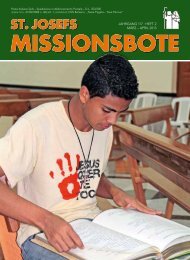
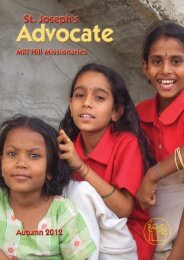
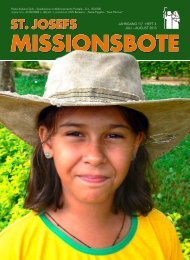

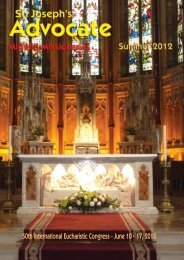
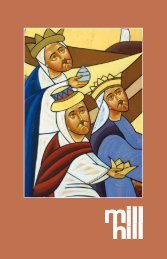
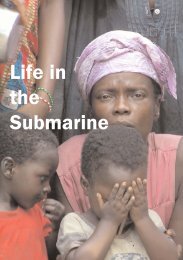
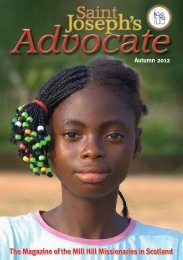

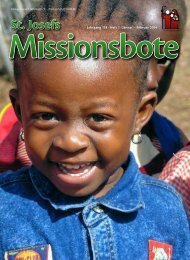
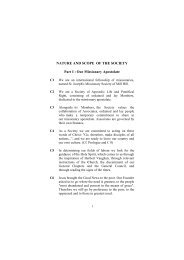

![Summer 2012 [pdf] - The Mill Hill Missionaries](https://img.yumpu.com/43011464/1/184x260/summer-2012-pdf-the-mill-hill-missionaries.jpg?quality=85)